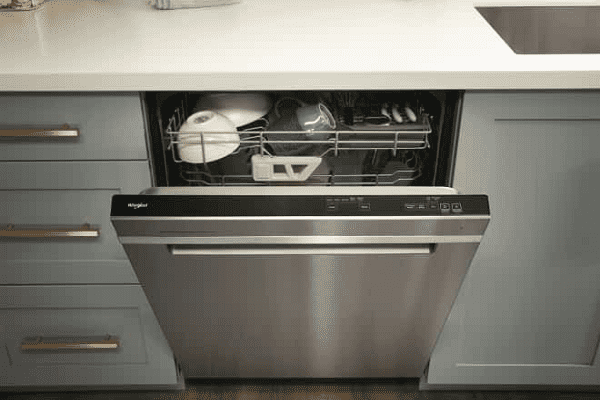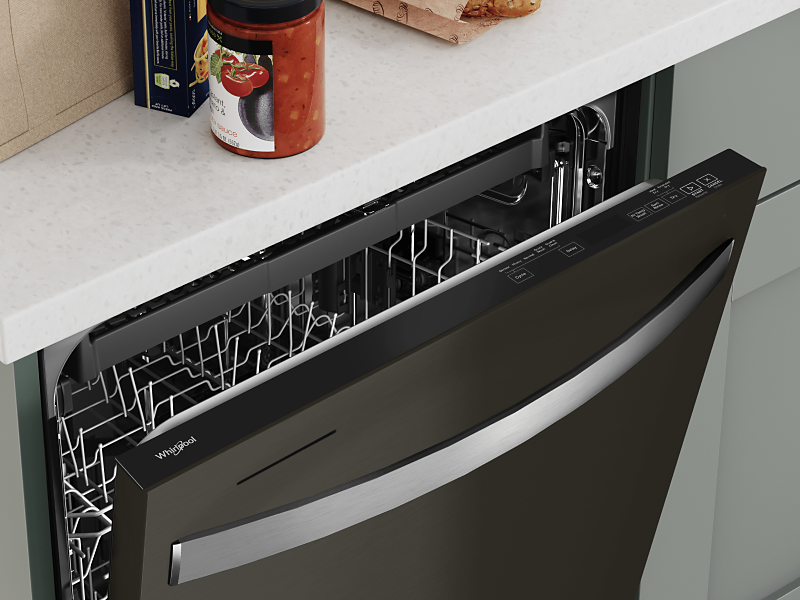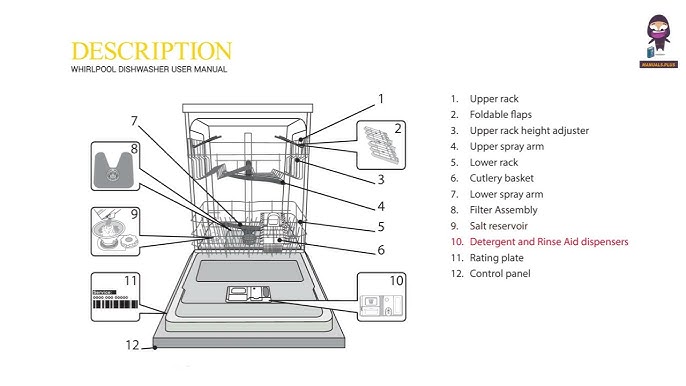
Whirlpool dishwashers are known for their reliability and efficiency. But even the best appliances can face issues.
If your Whirlpool dishwasher isn’t working right, don’t worry. Many problems have simple solutions. In this guide, we will explore common issues and how to fix them. Understanding these troubleshooting steps can save time and money. You won’t need to call a technician for every small problem.
Instead, you can handle many repairs on your own. This knowledge is empowering and practical. So, let’s dive into the world of Whirlpool dishwasher troubleshooting. We’ll help you get your dishwasher back to peak performance in no time.

Credit: www.whirlpool.com
Dishwasher Not Starting
Is your Whirlpool dishwasher not starting? Don’t worry. This common issue often has simple solutions. Before you call a technician, there are a few things to check. Below are two key areas to inspect when your dishwasher won’t start.
Check Power Supply
The first step is to check the power supply. Ensure the dishwasher is plugged in properly. Look at the outlet and the power cord. Sometimes, the outlet may have tripped. Reset the circuit breaker if needed. Confirm the power switch is turned on. If the dishwasher still does not start, you may have a power issue.
Inspect Door Latch
Next, inspect the door latch. The dishwasher won’t start if the door isn’t closed properly. Ensure the latch is secure. Open and close the door firmly. Look for any signs of damage. A broken latch can prevent the machine from running. If the latch is faulty, you might need a replacement part.

Credit: www.reddit.com
Water Not Draining
A Whirlpool dishwasher not draining could be caused by a clogged filter or a blocked drain hose. Cleaning these parts often resolves the issue quickly.
If you’ve ever opened your Whirlpool dishwasher to find standing water at the bottom, you know how frustrating it can be. Water not draining properly is a common issue, but it doesn’t have to be a headache. Let’s walk through some practical steps to troubleshoot and fix this problem.Clean Drain Filter
First, let’s check the drain filter. A clogged filter can prevent water from draining. Start by removing the bottom rack of your dishwasher. Locate the drain filter—it’s usually at the bottom near the center. Twist the filter counterclockwise to remove it. Rinse the filter under warm water to clear out any food particles or debris. Reinstall the filter by twisting it clockwise until it locks into place. You’d be surprised how often this simple step resolves the draining issue!Check Drain Hose
Next, examine the drain hose. A kinked or clogged hose can block water from exiting the dishwasher. Unplug your dishwasher and pull it away from the wall to access the hose. Check for any kinks or bends in the hose. Straighten them out if you find any. Disconnect the hose from the dishwasher and the sink drain. Have a bucket ready to catch any water. Run water through the hose to check for blockages. If water doesn’t flow freely, use a long, flexible brush to clear any obstructions. Reattach the hose securely to both the dishwasher and the sink drain. Regular maintenance can prevent these issues from happening again. Have you ever found yourself frustrated with a similar problem? What worked for you? Share your experience in the comments!Dishes Not Getting Clean
Is your Whirlpool dishwasher not cleaning your dishes properly? This issue can be frustrating. Several factors might cause this. Below are some tips to help solve this problem.
Ensure Proper Loading
Loading the dishwasher correctly is crucial. Place dishes facing down. Ensure that no item blocks the spray arms. Avoid overcrowding. This can prevent water from reaching all dishes. Follow the manufacturer’s loading guidelines for best results.
Check Spray Arms
The spray arms are vital for cleaning. Check if they spin freely. Remove any debris that might block the holes. Clean the spray arms regularly. This ensures water flows at full pressure. Proper maintenance helps your dishwasher work efficiently.
Dishwasher Leaking
A leaking dishwasher can be frustrating and potentially damaging to your kitchen. If you notice water pooling around your Whirlpool dishwasher, it’s essential to identify the source of the leak and address it promptly. Below are some key troubleshooting steps to help you fix the issue and get your dishwasher back to working order.
Inspect Door Seal
The door seal is a critical component that prevents water from leaking out of the dishwasher. Over time, it can wear out or become damaged.
Carefully examine the rubber seal around the door for cracks, tears, or any signs of wear. If you find any damage, replacing the seal can often solve the leaking problem.
Clean the seal regularly to ensure it’s free from debris and build-up that could compromise its effectiveness. A clean seal creates a tighter fit, reducing the risk of leaks.
Check Water Inlet Valve
The water inlet valve controls the flow of water into your dishwasher. A faulty valve can cause leaks.
Inspect the valve for signs of damage or corrosion. If you notice any issues, you may need to replace the valve.
Ensure the connections to the valve are secure. Loose or damaged connections can lead to water leakage. Tighten any loose fittings to prevent this.
By addressing these key components, you can often fix common leaking issues with your Whirlpool dishwasher. Taking these steps can save you from costly repairs and keep your kitchen dry and safe.
Unusual Noises
Experiencing unusual noises from your Whirlpool dishwasher? Investigate potential causes like loose parts or foreign objects. Regular maintenance can help prevent these issues.
When your Whirlpool dishwasher starts making unusual noises, it can be quite concerning. These noises can range from grinding and buzzing to rattling and squealing. Understanding the cause of these sounds can help you fix the issue and keep your dishwasher running smoothly.Identify Noise Source
Begin by identifying where the noise is coming from. Is it from the bottom of the dishwasher, the door, or the spray arms? Different sounds can indicate different problems. A grinding noise might point to an issue with the motor, while a rattling sound could mean something is loose.Check For Obstructions
Next, check for any obstructions inside the dishwasher. Sometimes, utensils or small items can fall through the racks and block the spray arms. Look for pieces of food, broken glass, or other debris that might be causing the noise. If you find anything, remove it carefully to avoid damaging your dishwasher. By following these steps, you can often resolve the problem without needing professional help. So next time you hear an unusual noise, don’t panic. Instead, roll up your sleeves and get to the root of the issue. Is there a particular sound that has you puzzled? Let us know in the comments!Dishwasher Not Drying Dishes
Dealing with a Whirlpool dishwasher that isn’t drying dishes can be frustrating. You expect your dishes to come out clean and dry, ready to be put away. But when they come out wet, it can be annoying and time-consuming. Fortunately, there are several steps you can take to troubleshoot and solve this issue.
Use Rinse Aid
Rinse aid can make a significant difference in how your dishes dry. It helps water slide off dishes more easily, reducing water spots and speeding up the drying process. If you haven’t been using rinse aid, it’s worth giving it a try.
Check your dishwasher’s rinse aid dispenser. If it’s empty, fill it up. Many dishwashers have a setting to adjust the amount of rinse aid used. Start with a medium setting and adjust as needed based on the results.
I once had a similar issue, and adding rinse aid worked wonders. It might just be the simple solution you need to get your dishes dry and spotless.
Check Heating Element
The heating element is crucial for drying dishes. If it’s not working, your dishwasher won’t be able to dry your dishes effectively. To check if the heating element is the problem, inspect it for any visible damage.
Turn off the power to the dishwasher and look at the heating element at the bottom of the dishwasher. If it looks burnt or broken, it might need replacement. You can also use a multimeter to check if it’s working correctly.
Replacing a heating element isn’t as daunting as it sounds. If you’re comfortable with a bit of DIY, you can find detailed instructions online or in your dishwasher’s manual. Or, you might want to call a professional if you’re unsure.
Have you ever had to deal with a malfunctioning heating element? How did you handle it? Share your experience in the comments below!
Ensuring your Whirlpool dishwasher dries dishes properly involves a few checks and adjustments. By using rinse aid and checking the heating element, you can often solve the issue quickly and effectively. Taking these steps can save you time and keep your kitchen running smoothly.
Error Codes
Whirlpool dishwashers are efficient, but sometimes they show error codes. These codes help diagnose problems. Understanding them can save time and money. Below, we discuss common error codes and how to resolve them.
Common Error Codes
Whirlpool dishwashers display various error codes. Here are some common ones:
- E1/F1: Water supply issue.
- E2/F2: Drainage problem.
- E3/F3: Heating fault.
- E4/F4: Water level sensor issue.
- E5/F5: Door latch problem.
Steps To Resolve
Each error code has specific steps for resolution.
E1/F1: Check the water supply. Ensure the hose is not kinked.
E2/F2: Clean the filter. Check the drain hose for blockages.
E3/F3: Inspect the heating element. Replace if faulty.
E4/F4: Check the water level sensor. Clean it if dirty.
E5/F5: Ensure the door is properly closed. Check the latch for damage.
Following these steps can help fix many issues. If the problem persists, contact a professional.
Maintenance Tips
Fixing common issues with a Whirlpool dishwasher can be simple. Check the filter and spray arms for blockages. Ensure proper loading to avoid poor cleaning results.
Maintaining your Whirlpool dishwasher is essential for keeping it in top working condition. Regular maintenance can prevent common issues and ensure your appliance lasts longer. Let’s dive into some practical tips to keep your dishwasher running smoothly.Regular Cleaning
Regular cleaning is crucial to prevent buildup and maintain efficiency. Start by cleaning the filter. Remove it and rinse under hot water to eliminate food particles. Wipe down the door and the rubber gasket with a damp cloth. This helps to remove any residue or grime that may cause odors or affect the seal. Use a dishwasher cleaner once a month. It helps to clear out any buildup inside the machine, ensuring it stays fresh and performs well.Routine Inspections
Routine inspections can catch potential problems early. Check the spray arms for blockages. Food particles can clog the holes, reducing the efficiency of your dishwasher. Look at the seals around the door. If they are cracked or worn, they may need to be replaced to prevent leaks. Inspect the dishwasher’s interior for signs of rust or wear. Addressing these issues early can prevent more significant problems later. By following these maintenance tips, you can keep your Whirlpool dishwasher in excellent condition. Have you ever had an issue with your dishwasher that regular maintenance could have prevented?
Credit: www.youtube.com
Frequently Asked Questions
How Do I Run Diagnostics On My Whirlpool Dishwasher?
To run diagnostics on a Whirlpool dishwasher, press “Heated Dry” followed by “Normal” three times. Then, press “Start. ” The diagnostic cycle will begin.
What Are The Most Common Faults With A Dishwasher?
Common dishwasher faults include clogged filters, faulty door seals, broken spray arms, drainage problems, and malfunctioning heating elements.
How Do You Reset A Whirlpool Dishwasher?
To reset a Whirlpool dishwasher, press the “Cancel/Drain” button twice. Wait for it to drain completely. Then, disconnect the power for a minute and reconnect.
What Are The Error Codes For A Whirlpool Dishwasher?
Whirlpool dishwasher error codes include F1 (water supply issue), F2 (drain problem), F3 (heating issue), F4 (sensor fault), and F5 (door latch issue).
Conclusion
Troubleshooting your Whirlpool dishwasher can be simple with the right steps. Follow this guide to fix common issues and keep your dishwasher running smoothly. Regular maintenance helps avoid future problems. Always consult your manual for specific instructions. If problems persist, contact a professional.
Keeping your dishwasher in good shape saves you time and money. Happy cleaning!






